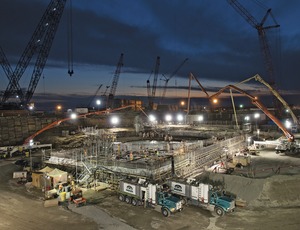
On March 11, two years after the meltdown at Japan's Fukushima Daiichi nuclear plant, crews at South Carolina Gas and Electric's V.C. Summer Unit 2 marked a more auspicious milestone: the first concrete pour at a U.S. nuclear powerplant in 30 years.
Three days later, crews at Southern Nuclear's Vogtle Unit 3 in Georgia completed another pour. "This has been a week of momentous progress in bringing a new generation of safe, clean, reliable nuclear energy to the United States," said Westinghouse Electric Co. President and CEO Danny Roderick.
CB&I and Westinghouse, the consortium building the AP1000 pressurized-water reactor units, supervised work at both sites. The concrete basemat will provide a foundation for the nuclear containment and auxiliary buildings within the nuclear island, which includes the containment vessels and shield buildings.
"The successful placement of the first new-construction nuclear concrete … is an extraordinary milestone not only for the V.C. Summer project but for the entire nuclear industry," said Lasse Petterson, chief operating officer and executive vice president of CB&I's engineering, construction and maintenance operating group. CB&I provided the engineering, construction, procurement and project-management services throughout the pours at both sites.
While V.C. Summer's pour took 51.5 hours, Vogtle's took 41. At each site, the 6-ft-thick basemat required 7,000 cu yd of concrete and covered a 250-ft-long, 160-ft-wide area. Southern says the full outlines of the nuclear island have been completed to grade level and the components for erecting the containment vessel are completed and staged for installation once the basemat concrete has cured.
At both sites, the process will be repeated for additional planned units; also, the first reactors are expected to be in service in 2017, and the second units are planned to come on line in 2018.
In Japan, contractors are dismantling the melted reactors. TransNuclear Ltd., a joint venture between AREVA and Kobe Steel Ltd., recently delivered the first three metallic casks for the dry storage of the spent fuel rods stored in the common pool, which was not damaged in the earthquake and tsunami that struck the Japanese coast on March 11, 2011. Nine similar casks at Fukushima were undamaged by the disaster.

Post a comment to this article
Report Abusive Comment